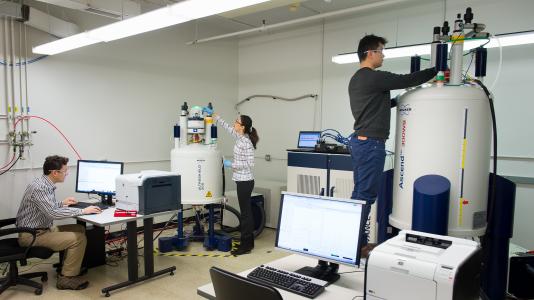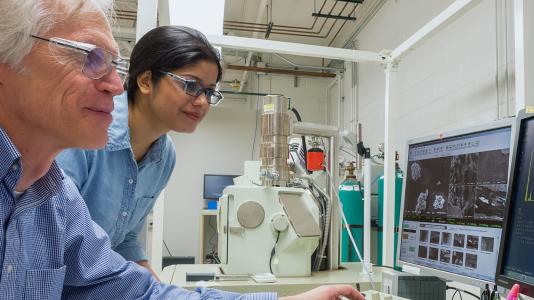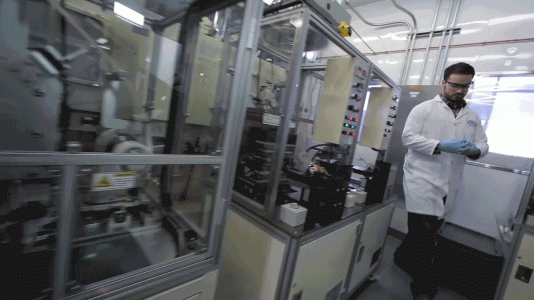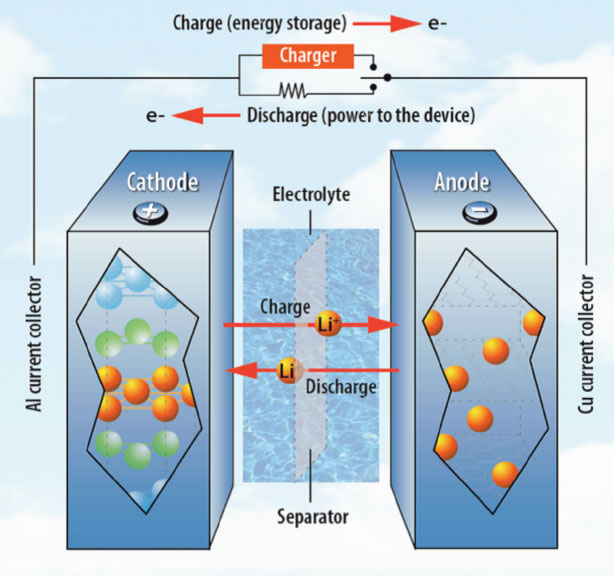batteries
Below is a comprehensive list of articles, events, projects, references and research related content that is specific to the term described above. Use the filter to narrow the results further. To explore additional science and technology topics that Argonne researchers and engineers may be working on please visit our Research Index.
- Composite anode material for lithium-ion batteriesIntellectual Property Available to LicenseUS Patent 9,054,373 B2 and US Patent 9,620,773 B2
- Anode Materials for Lithium Ion Batteries (ANL-IN-10-013)
A composite anode material with general formula (1-x)J-(x)Q wherein: J is a silicon-containing metal carbon alloy; and Q is a metal oxide.
Benefit
- High reversible capacity and improved cyclability with minimal volume change with cycling
View the Patent Details
Anode materials for lithium ion batteries (US 9,054,373 B2)
Anode materials for lithium ion batteries (US 9,620,773 B2) - Additives could help make batteries safer, more economicalIntellectual Property Available to License
Figure 1. Charge Transfer Mechanism for Li-ion Battery Overcharge Protection — The boron and fluorine additive is in the electro The Invention
A series of novel redox shuttle additives for lithium ion batteries for the purpose of overcharge protection and increased battery safety.
The additives not only can provide excellent overcharge protection in lithium-ion batteries but are also compatible with conventional carbonate-based electrolytes. These novel shuttle additives also provide improved solubility in carbonate based electrolyte.
As the demand for hybrid and electric vehicles continues to grow, so does the demand for lithium-ion batteries that are safer, more powerful, and less expensive. These Argonne additives will help meet that demand.
Benefits
- Prevent overcharge and improves safety,
- Balance cell in a battery pack,
- Reduce cost, and
- Increase battery reliability.
Applications and Industries
- Electrodes used in batteries for
- Electric and plug-in hybrid electric vehicles;
- Portable electronic devices;
- Medical devices; and
- Space, aeronautical, and defense-related devices.
Developmental Stage
The various redox shuttle technologies are at several stages of development.
Intellectual Property
- ANL-IN-05-012, “Novel Redox Shuttles for Overcharge Protection of Lithium Ion Batteries”, U.S. Patent 7,851,092, GB issued patent 2,437,902; Inventors: Khalil Amine, Qingzheng Wang and Zonghai Chen
- ANL-IN-08-024, “Electrolyte Salts for Lithium Batteries”, combined with ANL- IN-08-033, “Ionic Metal Complex Redox Shuttle for Lithium Ion Batteries”, U.S. Published Application 12/192,452; Inventors: Khalil Amine, Zhengcheng Zhang and Zonghai Chen
- ANL-IN-09-082, “Polyether-Functionalized Redox Shuttles for Lithium Ion Batteries”, U.S. Published Application 13/114,452; Inventors: Zhengcheng Zhang, Lu Zhang and Khalil Amine
- ANL-IN-09-084, “Redox Shuttle Additives for High Voltage Cathodes”, U.S. Published Application 13/114,468; Inventors: Lu Zhang, Zhengcheng Zhang, and Khalil Amine
- ANL-IN-09-086, “Redox Shuttle for Overcharge Protection of Lithium Ion Batteries”, U.S. Published Application 13/113,499; Inventors: Wei Weng, Zhengcheng Zhang and Khalil Amine
- ANL-IN-10-076, “Redox Shuttles for Overcharge Protection of Lithium Batteries”, U.S. Provisional Application 61,529,413; Inventors: Zhengcheng Zhang, Lu Zhang, and Khalil Amine
- ANL-IN-11-128, “Redox Shuttle for Overcharge Protection of Lithium Ion Batteries,” U.S. Patent Pending 13/457,239; Inventors: Wei Weng, Zhengcheng Zhang and Khalil Amine
CONTACT USSubmit a Partnership InquiryTo discuss a potential research partnership with Argonne or to inquire about licensing Argonne technology
-
![Argonne’s Electrochemical Analysis and Diagnostics Laboratory (EADL) provides reliable, independent, and unbiased evaluations of battery performance and life, which serve as progress measures for DOE and U.S. Advanced Battery Consortium projects. [Image courtesy of Argonne National Laboratory.]](https://www.anl.gov/sites/www/files/styles/article_teaser_16x9/public/2019-12/EADL_32751D099_1920x1080.jpg?h=d1cb525d&itok=zYLHICWg)
-

-

-

-

-

- New high-capacity cathode materials with high lithium content that can act as a reservoir for lithiumIntellectual Property Available to LicenseUS Patent 8,835,027
- Positive Electrodes for Lithium Batteries (ANL-IN-06-037)
The new materials have potential application in lithium-ion batteries with anodes such as graphite, graphene, and silicon. There is also potential application in batteries utilizing lithium metal anodes.
In this invention, cathode precursors that contain a large amount of lithium can be extracted electrochemically at high potentials to load metal or metal alloy substrates with lithium. In one example, lithium and oxygen ions are released from the cathode during an initial preconditioning charge of the cell. This process leaves a structurally modified compound in the charged cathode that can react with lithium on a subsequent discharge. In principle, the preconditioning step (i.e., the initial charge reaction) is largely irreversible, whereas the second step (the initial charge reaction) can be either reversible or irreversible. This technology is available for license.
Applications
High capacity electrodes used in lithium batteries for:
- Electric and plug-in hybrid electric vehicles;
- Stationary energy storage devices;
- Portable electronic devices;
- Medical devices; and
- Space, aeronautical, and defense-related devices.
CONTACT USSubmit a Partnership InquiryTo discuss a potential research partnership with Argonne or to inquire about licensing Argonne technology
Related People - State-of-the-art tool kit for fitting battery aging data and for battery life estimationIntellectual Property Available to License
Argonne’s Battery Life Estimator (BLE) software is a state-of-the-art tool kit for fitting battery aging data and for battery life estimation. It was designed to make life-cycle estimates using two years of aging data.
BLE helps answer key questions on how battery performance will change with calendar age, cycles, internal component aging, cell-to-cell manufacturing variations, summer and winter temperature extremes, differing anode and cathode materials, and electrolyte variations and additives.
The software employs a generalized statistical approach to fit data from accelerated aging experiments to a life equation. The BLE software is different from other curve-fitting routines as it employs robust fitting techniques and estimates battery life by using Monte Carlo techniques (which most generalized curve-fitting software does not consider).
Applications
- Fit battery aging data to life equations
- Estimate battery life
Features
- Easy to learn
- Fast run times
- Easy-to-use graphical user interface
- User guide includes examples and frequently asked questions
Technical Details/Requirements
- Requires PC computer with a Pentium 4 processor, 1 GB of memory and VGA graphics
- Operates on a Windows 2000 or later system and requires Microsoft .NET framework versions 1.1 through 3.5
CONTACT USSubmit a Partnership InquiryTo discuss a potential research partnership with Argonne or to inquire about licensing Argonne technology
